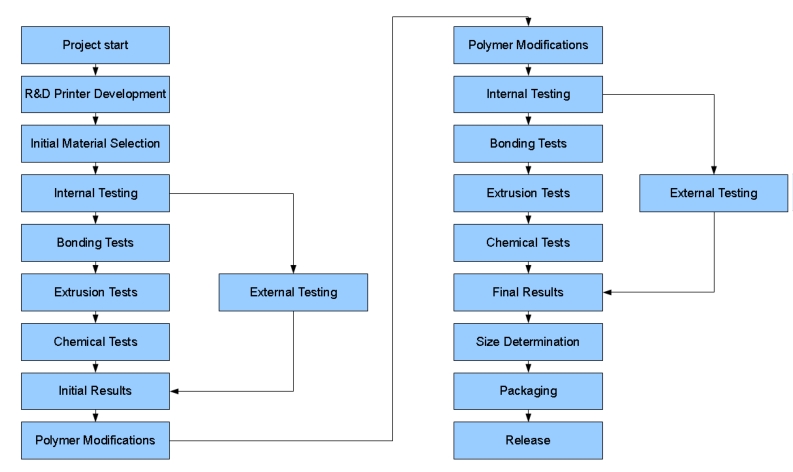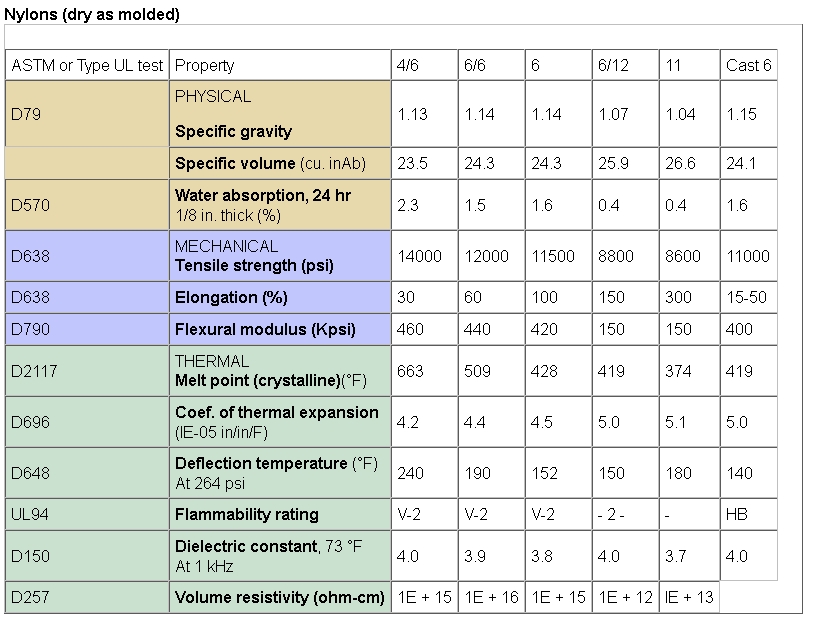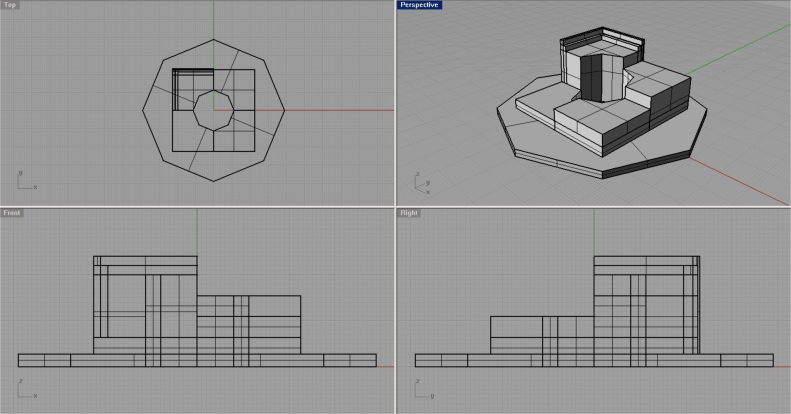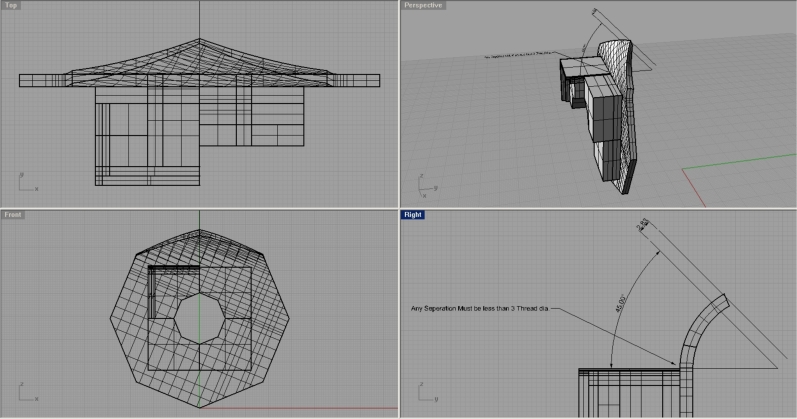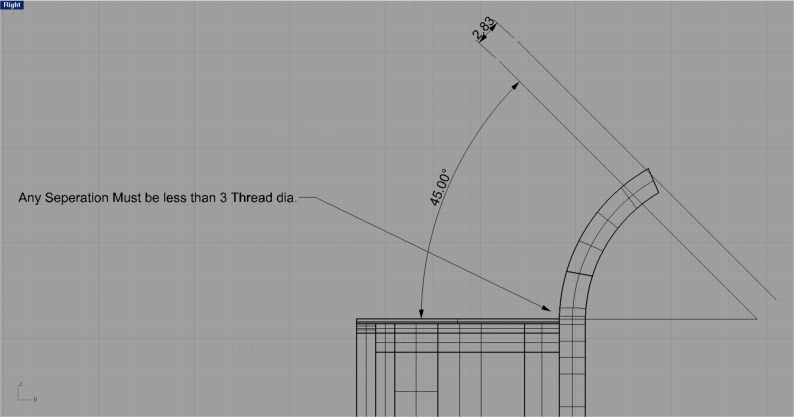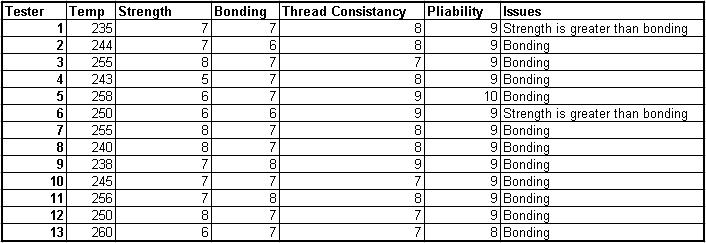User:Taulman
Development of 618 Nylon Co-Polymer for use in all RepRap type/style 3D Printers
( A special Thank You! goes out to everyone in the 3D Printing Community that participated in testing)
Milestones:
Development Start Date: 3/12/2012
Purpose:
- To develop a very high strength, 100% bonding material capable of being used in all RepRap style printers.
As there are now hundreds of 3D Design and prototype houses supporting the ever growing high technology needs, the ability to make quick turn prototypes is a must for the successful design firm. While the RepRap style printers may be some time away from the surface aesthetics of the larger and more expensive proprietary 3D Printers, most of these 3D print technologies have difficulty in the “function” portion of “Form/Fit/Function” demands of the industry. All of those in these design firms fear the one question asked by a new Customer, i.e. “So…can I put this 3D Printed part in my newly designed lawn mower transmission and power it up?” Until now, the answer has always been “no” or one filled with conditions. The goal of this development was to allow these design houses the ability to say…”Absolutely….not only that, but you can run it as hot as 120F and immerse it in any transmission oils you want!”. This raises the quality and properties bar significantly for all user/operators of RepRap style 3D Printers.
Top Tier Requirements:
1.> than 98% bonding thread to thread.
- a.This must be a measurable capability with written calibration and acceptance testing for traceability.
2.Printing temperature range to be within the delta of current and older model RepRap style printers.
- a. i.e. 200C to 260C
3.Non Scratch surface.
- a.The material must be of a consistency and polymer make up such that no material “dust” would be emitted during mechanical processing.
- b.The material must “cut” rather than “scratch”.
4.Strength.
- a.The material should hold up to extreme abuse to the point of “tearing” rather than splitting or delaminating.
5.Chemical resistance.
- a.The material must be able to sustain bonding when exposed to the widest pH range possible.
6.Surface
- a. As Slippery (Highly durable) surface as possible.
7.Temperature Stability.
- a.The material should maintain stability (limited deformation) over a defined temperature range.
8.Surface texture.
- a.No requirement other than noted in #6
9.Optical Properties.
- a.No requirement
10.Conductivity Properties
- a.No requirement
11.Antistatic Properties
- a.No requirement
12.Color Properties
- a.Must not affect any other property
- b.No requirement
Material selection.
In an effort not to overlook similar high strength materials, the following materials were purchased in 1/8th” diameter rods from various suppliers.
1. Acetal/Delrin
2. PolyCarbonate
3. Acrylic, both extruded and cast
4. PVC
5. Polypropylene
6. Polyethylene
Each of these polymers had difficulty in bonding, temperature and or 3D printing results.
Project Decision Tree
Project Start:
The author made the decision to define a new material based on experience in the plastics industry as well as an ever decreasing development timeline. In developing a new material, a decision was made to design a new 3D Printer. One that used larger forces in all axis’s. This would eliminate/reduce machine artifacts from the results of various material printing results. The results of this decision followed similar goals as the major RepRap goals. A machine was designed, to in turn design and build a 2nd machine, that was again in turn used to design and build a third machine. This design is documented and available as OS at the following URL: [1]
Initial Material Selection:
With the fully operational 2BEIGH3 3D Printer, initial testing began on a list of materials:
Nylon
Acetal/Delrin
PolyCarbonate
Acrylic, both extruded and cast
PVC
Polypropylene
Polyethylene
A decision was made to move forward with the various nylons as they provided the best overall results.
The following table shows the specification variables of the major nylon polymers.
This table is available at [2]
Several 3 meter sections of 1/8" rod were obtained of the following:
Nylon 6
Nylon 6/6
Nylon 6/11
Nylon 6/12
From the chart noted above and testing of the various base nylons, it was determined that the best base for a 3D Printing scenario would be in the Nylon 6 category. As bonding, temperature and tensile strength were the upper most desirable traits, Nylons 6/6, 6/11 and 6/12 were determined to be problematic. And while common nylon 6 has 3D Printing issues, it was believed we could overcome these issues with a determination of root cause and a slight modification to the material chain.
Testing for "ease of 3D Printing"
As there were no objects or calibration parts to help determine the quality of 3D Printed parts from poly-amides, we decided to contract out a design that when printed would relate the efficiency and quality of a material when printed on a 3D Printer. A local design agency provided us with a "Material Certification Object" This part is quickly skinned by any slicing SW. As designed, it will provide an indication of mechanical, thermal and bonding quality.
Material Certification Object
The object is made up of a thin wide six sided bonding platform.
The intent of this platform is two fold, 1st to isolate the effects of poor bonding to the table before the successive square is printed. 2nd is to allow for an attachment point for measurement of bonding from surface to a transition.
The next portion of the part is a successive set of connected vertical steps. This allows for 1st, the measurement of layer to layer thermal stability. 2nd, the performance of the material as an ever decreasing quantity of material is extruded to the same basic shape. The 3rd is to determine thread uniformity as the print area is reduced in steps.
It will be seen later on, that the viscosity of 618's nylon base significantly changes the extrusion dynamics within the nozzle.
Material Certification Object observations/evaluations
The following images show failures of different polymers and co-polymers during initial testing of the four main test part numbers.
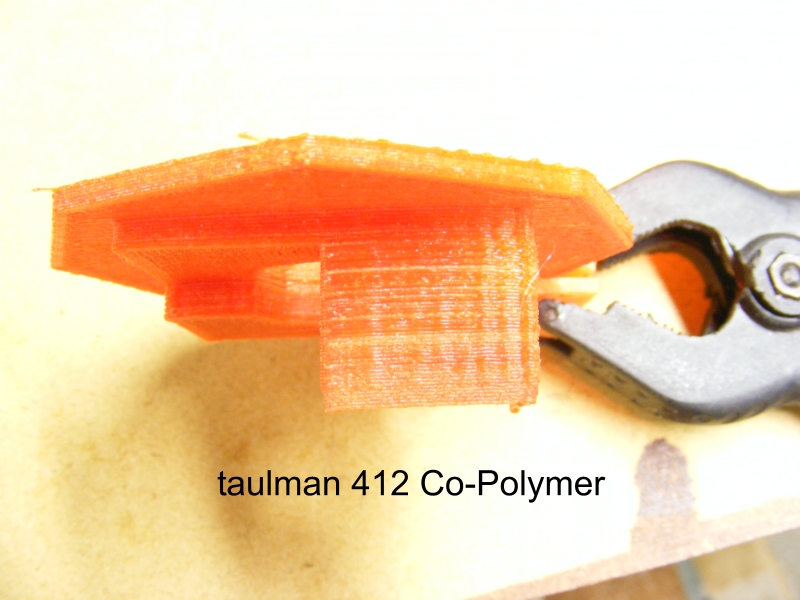
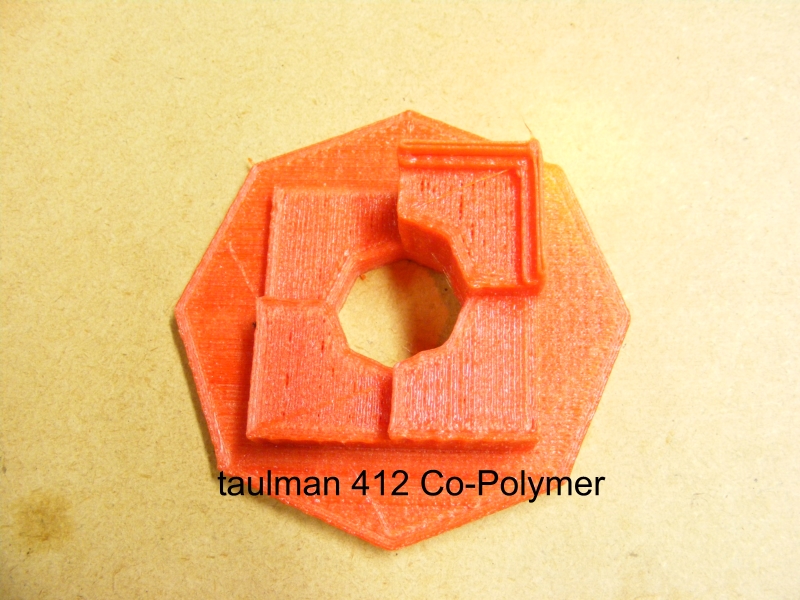
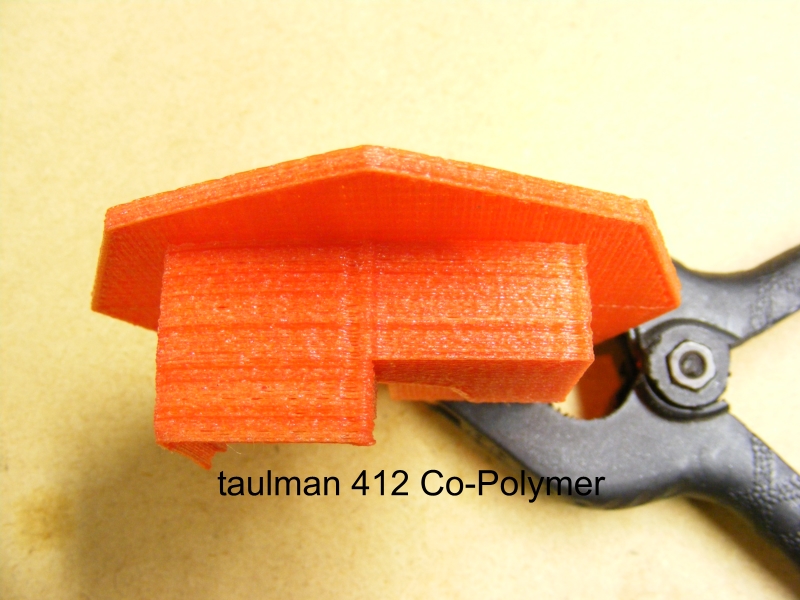
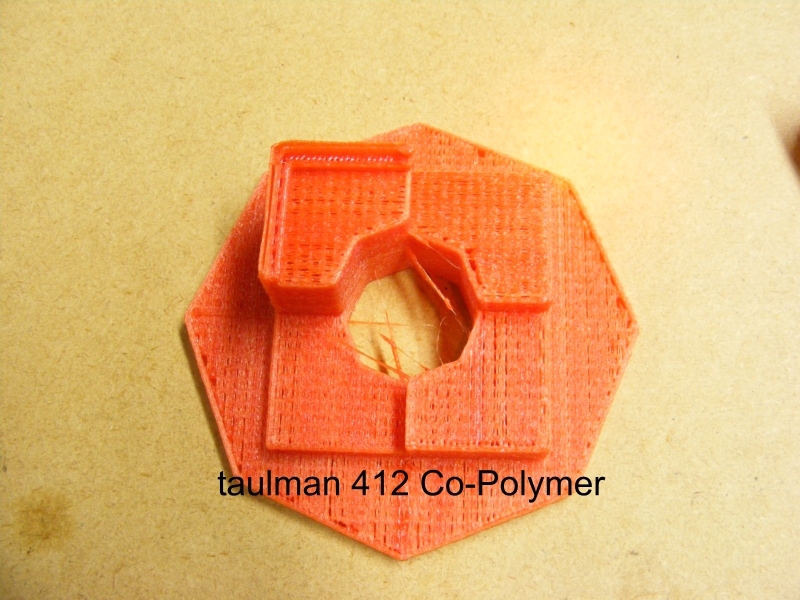
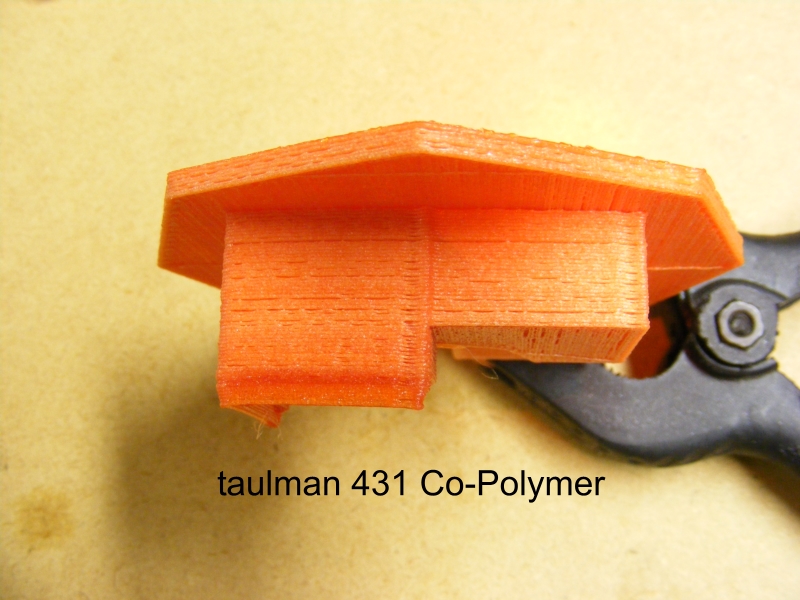
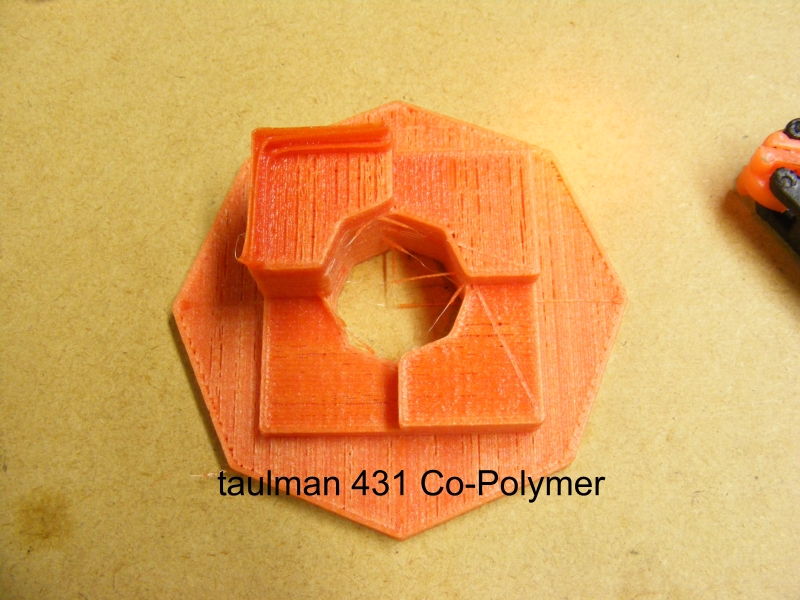
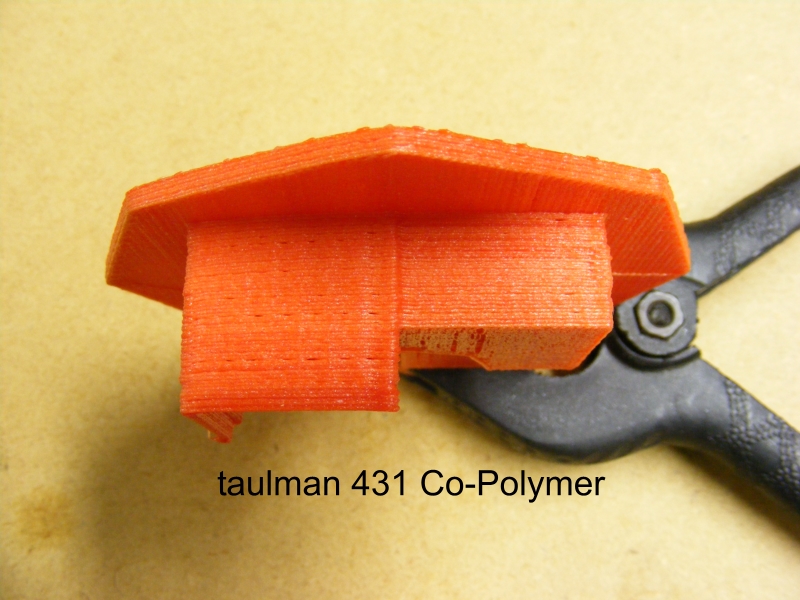
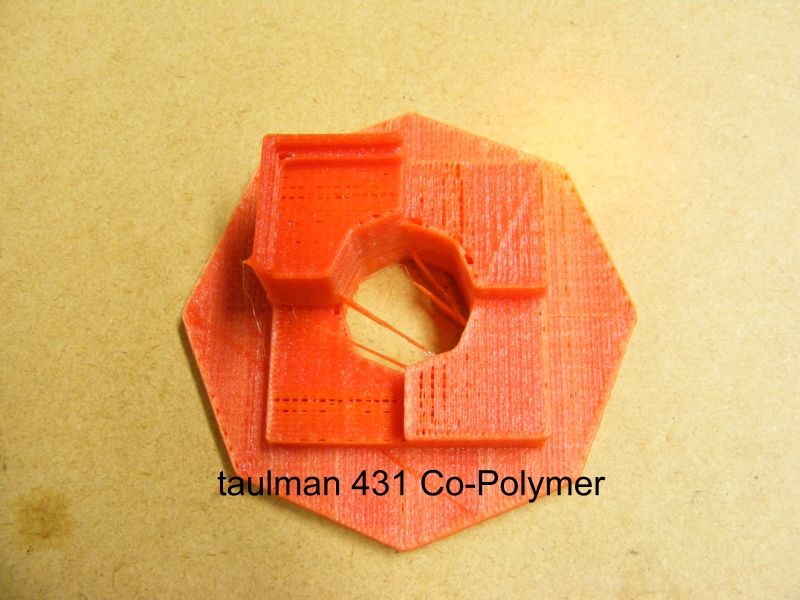
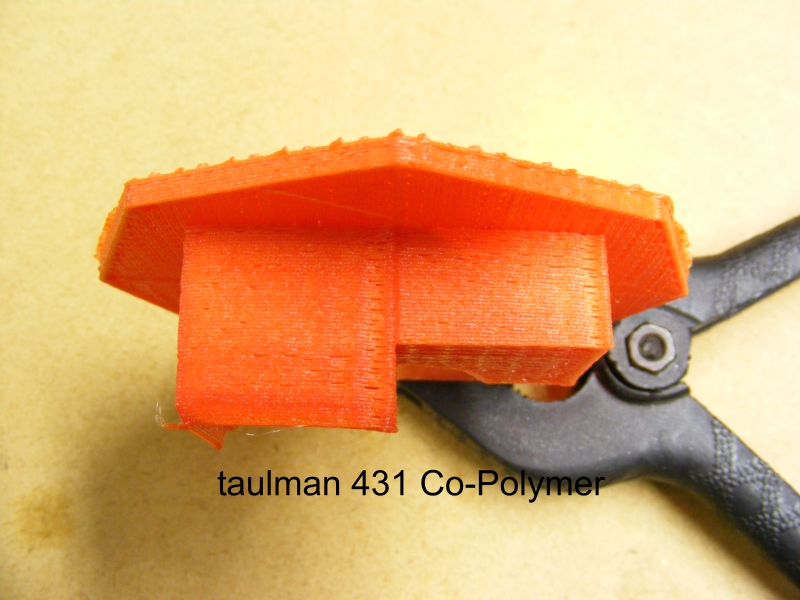
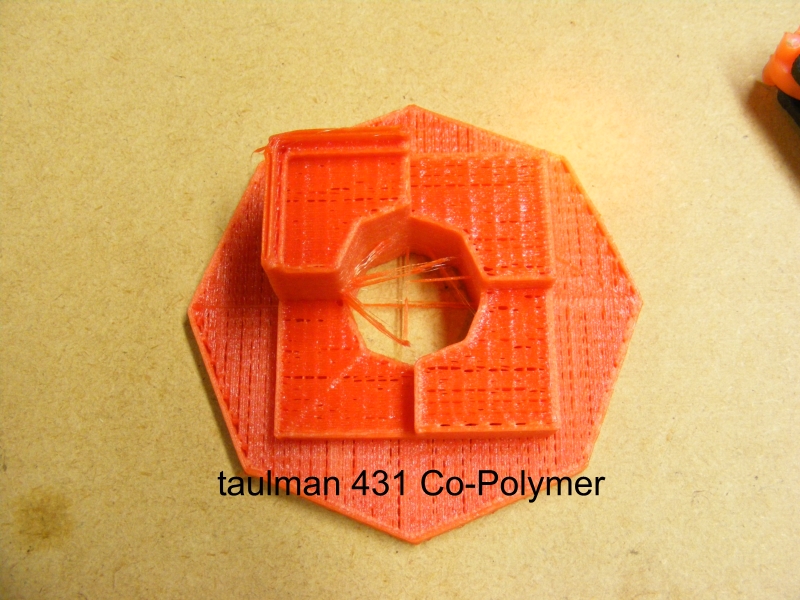
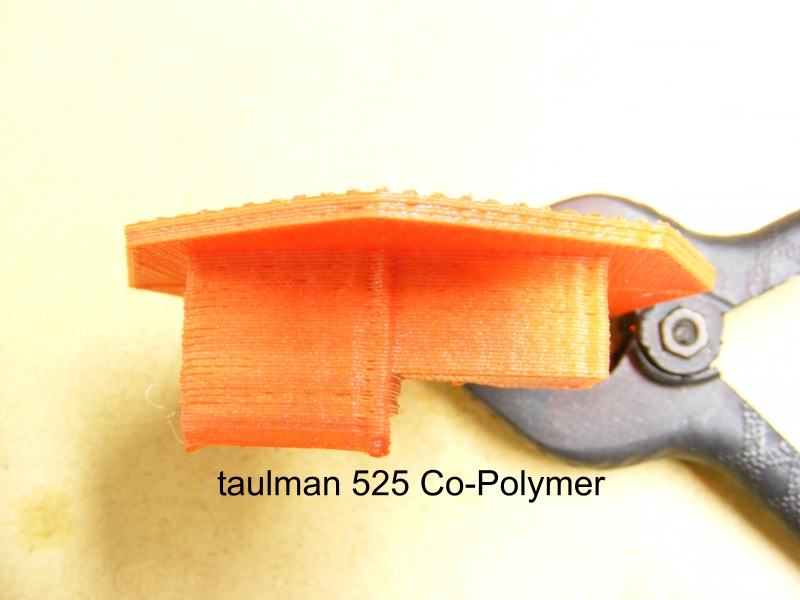
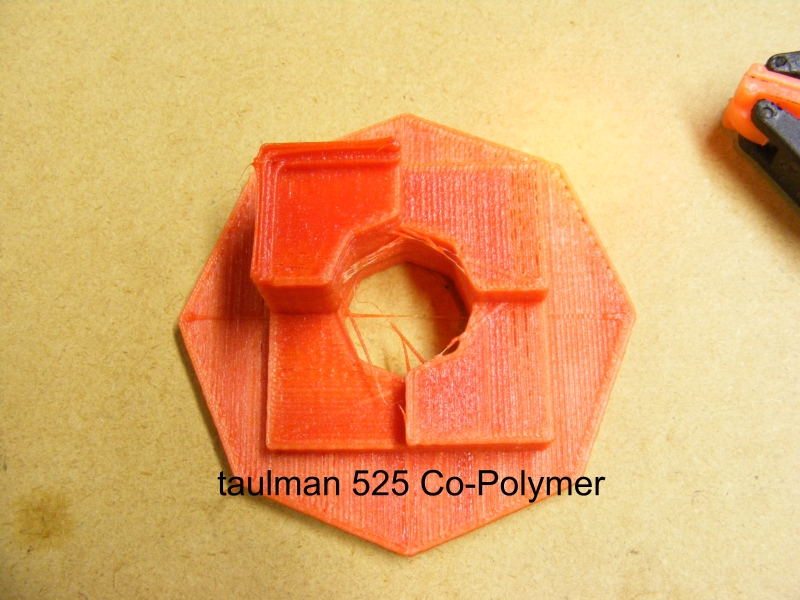
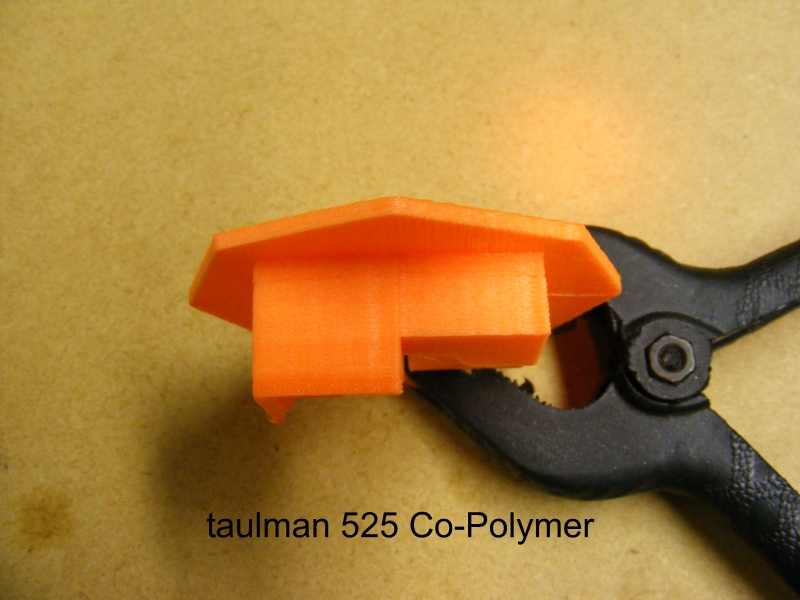
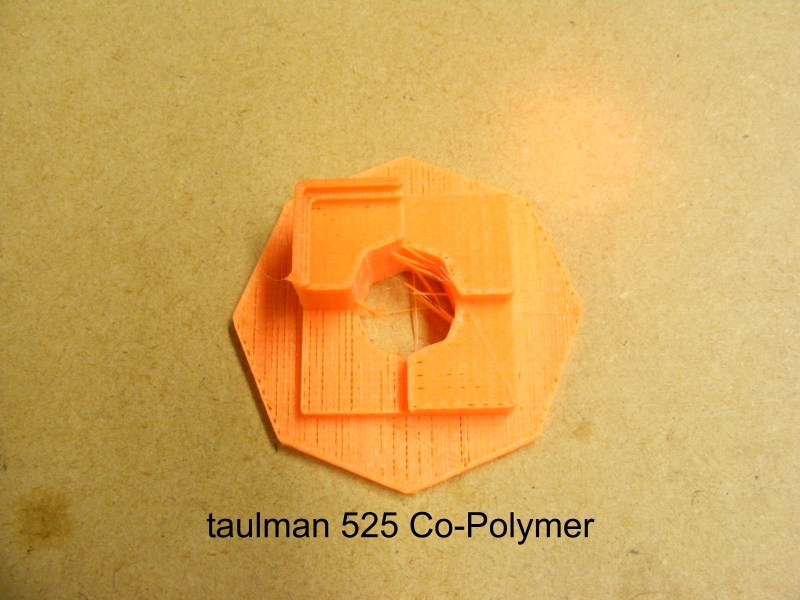
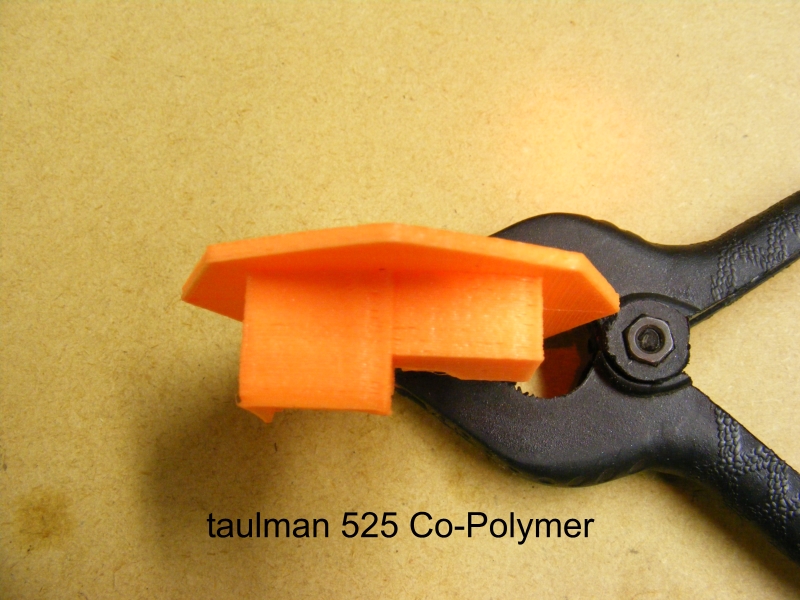
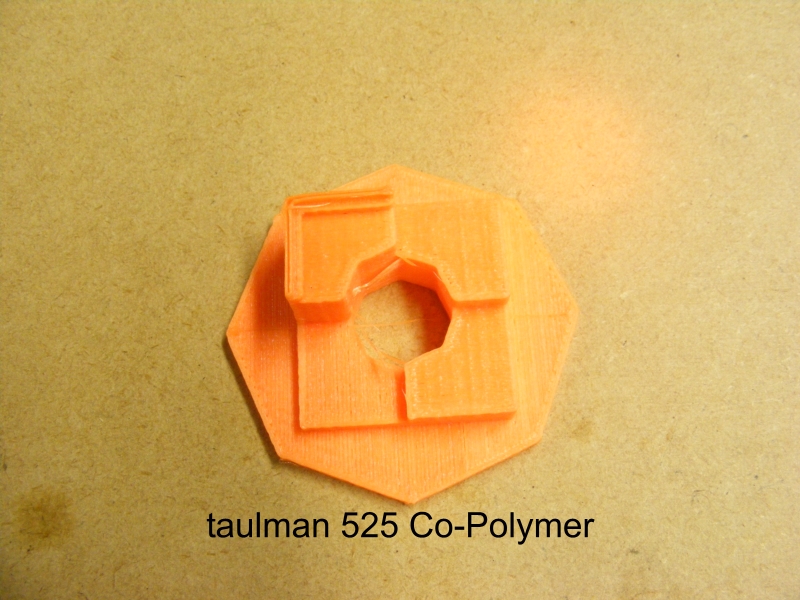
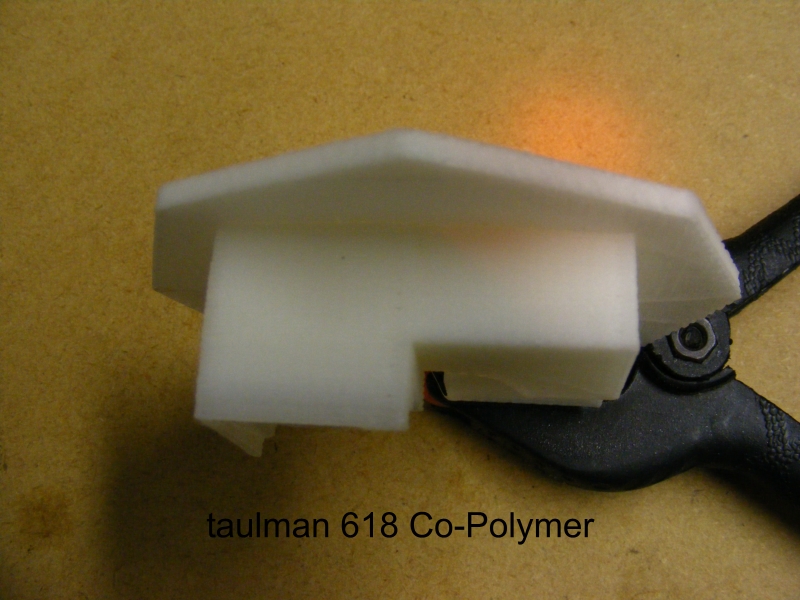
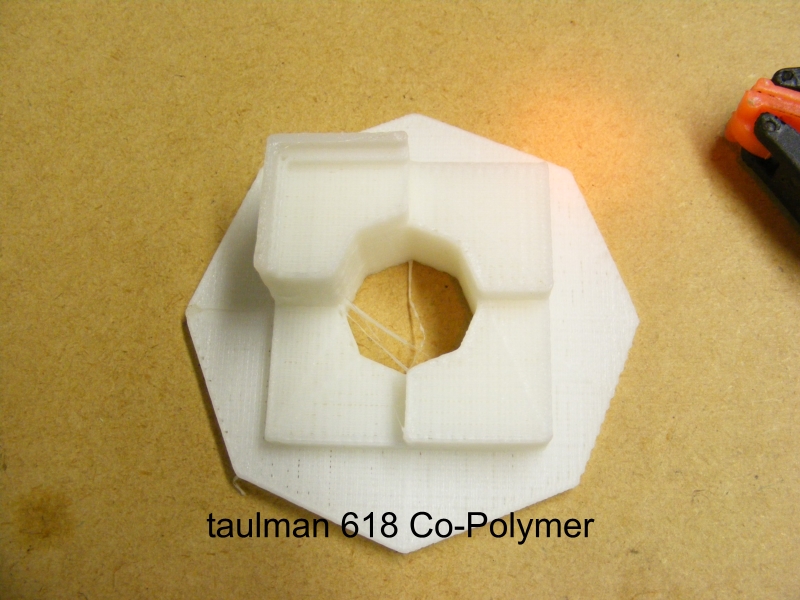
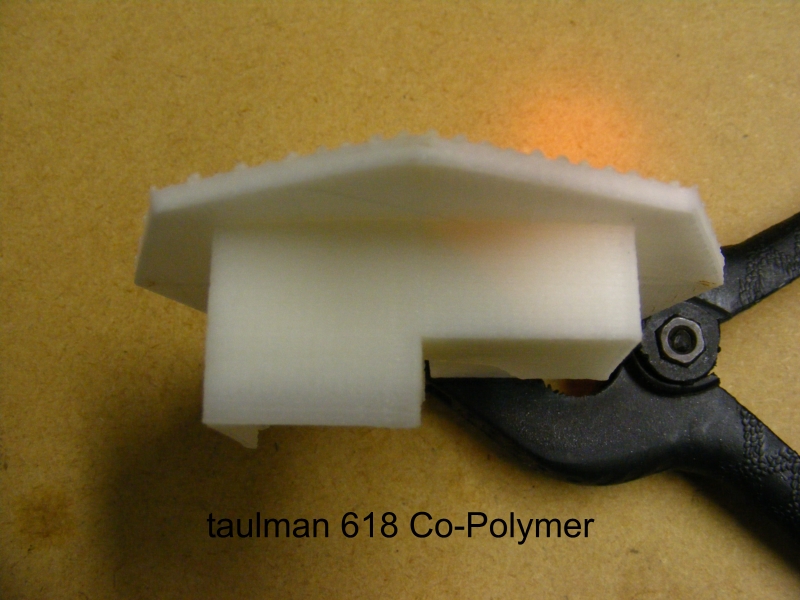
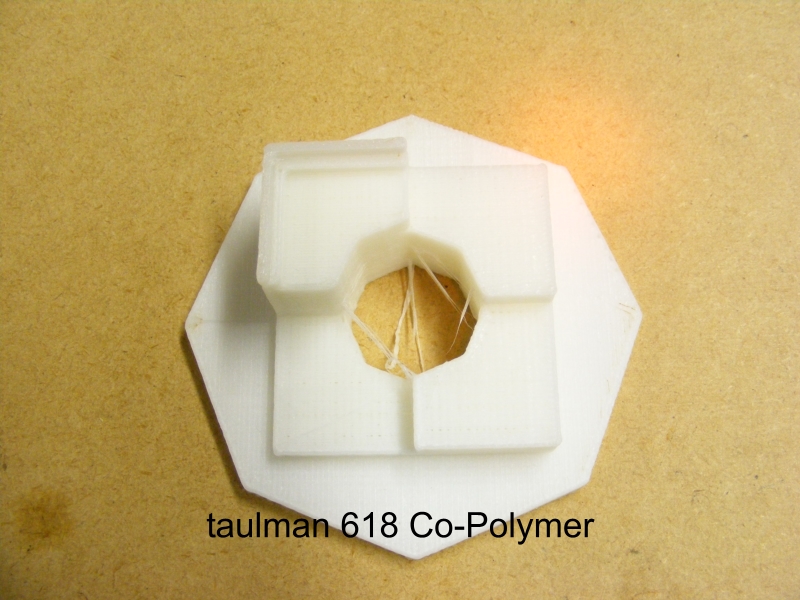
The four bases chosen for evaluation were referenced as:
- taulman 412 - A standard base nylon 6 with slightly elevated pH and a normal cooling cycle during extrusion.
- taulman 431 - A standard base nylon 6 with a normal pH, additives included UV blocking chemicals and again a normal cooling cycle during extrusion.
- taulman 525 - A High End Co-Polymer Nylon 6 with a hi pH, UV blocking, a calcium based additive for strength and a two stage chiller for cooling.
- taulman 618 Rev A - A very High End Co-Polymer Nylon 6 with a 7.32pH (pH Neutral), no additives and a three stage chiller for fast cooling.
- As can be seen in the photos above there are various inconsistencies in thread width from transition to transition. In some cases gaps and in others a sort of glob or material thickness inconsistency.
Hundreds of certification parts were printed with each part and an average of printed performance was used to make the determination as to usability in a reprap type 3D Printer. While it eventually became obvious that taulman 618 was a better polymer for 3D Printing, we needed to determine the problems of the other nylons, as a basis for enhancing 618. 618 Rev A was sent out to various testers to determine "printability" and get feedback on any issues. There were 4 internal testers to taulman3D and 9 outside initial testers that got 100' of 618 Rev A
This is a chart of the major comments received from 618 Rev A testing.
It was noted that as parts were printed, then destroyed, that while the individual layers were extremely strong, the bonding from layer to layer was an issue that had to be resolved.
The fact that taulman 412, while proving to have a very inconsistent thread width, actually proved a bit better at bonding as opposed to 618 Rev A, and in turn dictated that both the chemical chain as well as the processing would need to be investigated.
A decision was made to pursue 618, but make the necessary chemical changes and or processing adjustments to meet the project goals.
Three specialists were brought in to participate in a round table discussion with the goal of defining a specific sequence of steps needed to improve 618.
A Chemist with Industry polymer credentials.
A Physicist with thermodynamic experience.
A Mechanical Engineer with Flow Dynamics experience.
The group was provided parts prior to the meeting in order to have a visual/tactile reference.
Each was provided the following:
- 10 samples of the Material Certification Object, each printed at increasing temperatures from 230C to 270C
- 4 samples of single thread cylinders.
- 40mm dia x 100mm tall
The outcome of the first meeting was a bit of a concern as two of the three invitees, expressed doubts that bonding could be increased in a reprap style 3D Printing operation. This was directed primarily at the injection/extrusion of material into a die-less environment where the only mechanical limit was the thread or surface being printed over. And that proof of the die-less mechanics lack of bonding could be seen in the printed parts.
The following statement was determined as fact with respect to thread bonding:
- The flow of molten nylon onto another thread of molten nylon would guarantee bonding.
- The flow of molten nylon onto another thread of cooled nylon would not guarantee bonding without either force or optimum thermal contact.
The groups was given a brief review of taulman 412, 431, 525 and 618. There was a short investigation as to the reason 412 showed better bonding than the other polymers. It was determined that the 412 line was .2mm larger in diameter than the other lines. This justified the portion of the above statement with respect to "force". Basically, there was more material pressing into existing material during the print process. This resulted in a larger thread to thread surface contact and was determined to be essentially equal to "force".
The one remaining variable was "optimum thermal contact".
It was determined at this point that while 618 rev A was a better choice, it was absolutely failing in meeting the original material requirement. While parts and objects printed in 618 Rev A had esthetic qualities such as sheen and texture, these were not even on the list of requirements.
taulman3D made a decision to investigate thermal flow dynamics in order to substantially increase bonding if at all possible. As a side issue, there was concern as to "Print Consistency". Print Consistency was a term given to the consistency of the viscosity and diameter of the extruded thread. Discussions with injection molding facilities, provided additional information on the processing of nylon in a mold environment. It was learned that unlike shooting ABS molds, for nylons, the operators would slightly increase material temperatures and at the same time, increase the cooling cycle times. In some cases, the "hold pressure" was also increased "die and part dependent". "Clumping" was a term used to describe the viscosity of purged nylon materials. When a mold issue occurs or pins break, the material in the extruder barrel is purged as it can not be left hot. Unlike ABS, where styrene is lost over time, the nitrogen content of nylon is affected over time. Therefore, material is purged from the extruder. In most cases the purging can be observed. And this is where the term "Clumping" comes from. The material doesn't appear to be of a consistent viscosity. While this has little or no affect on injection molding, it was extremely important to RepRap style 3D Printing as basically, we're constantly purging material into the atmosphere.
